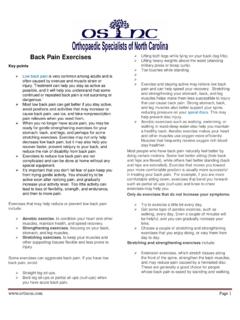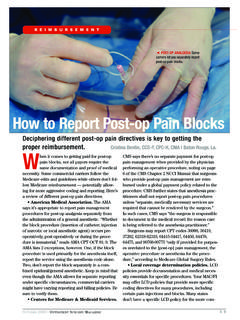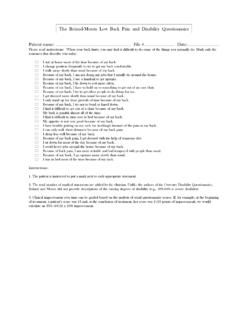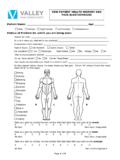Transcription of TMJ Dysfunction & Pain - Active Body Clinic
1 TMJ Dysfunction & pain The temporomandibular joints (TMJs) are two of the most functionally important and frequently used joints in the body. It is with these joints that important processes such as chewing, kissing, speaking, sucking, yawning and facial expressions are carried out. Unfortunately, TMJ Dysfunction is often a cause of numerous symptoms throughout the head and neck. It is through an understanding of the unique anatomy and biomechanics of these joints that a Physiotherapist can effectively assess and safely treat TMJ. pathology. Functional Anatomy The TMJ is a synovial, ovoid, condylar and hinge type joint. It is unique for several reasons. The articulating surfaces of the mandibular condyle and the mandibular fossa of the temporal bone must act as a pair and perform coordinated movements together. Further, the teeth affect movement by occlusion on mandibular elevation.
2 Along with the teeth, this joint is referred to as a "trijoint complex." There is a pronounced difference in shape between the articulating surfaces of this joint. Surprisingly, these surfaces are covered by avascular fibrocartilage as opposed to hyaline cartilage. Further, a fibrocartilaginous articulating disk (meniscus) divides each joint into an upper and lower joint cavity. This disc is innervated along its periphery but is aneural and avascular in its intermediate (force-bearing) zone. It is thicker posteriorly to "cover the thin bone at the bottom of the mandibular fossa". The disc's inferior surface is concave and covers the mandibular condyle, with medial and lateral attachments. Anteriorly, the disk is fused with the thin, loose and fibrous joint capsule and is directly attached to fibers of the upper head of the lateral pterygoid muscle.
3 While posteriorly, the disc and capsule are attached to a pad of loose connective tissue, which allows for easier anterior movement. The deep layers of the disk run at right angles to the bone and are adapted to inferior pressure, whereas the superficial fibers run parallel and are adapted to gliding under pressure. The ligaments which contribute to the formation of the fibrous joint capsule and unite the articulating bones are the temporomandibular ( lateral), sphenomandibular, and stylomandibular. The temporomandibular ligament restrains movement of the mandible and prevents compression of tissues behind the condyle. Some authors note that this collateral ligament is simply a thickening of the joint capsule. The sphenomandibular and stylomandibular ligaments keep the condyle, disk, and temporal bone firmly opposed. The latter is a specialized band of deep cerebral fascia with thickening of the parotid fascia.
4 Innervation of the TMJ is accomplished by the auriculotemporal and masseteric branches of the mandibular nerve. Arthrokinematics & Osteokinematics Translation (or gliding) occurs in the upper compartment of the TMJ while rotation (hinge movement) occurs in the lower Movement of the TMJ is accomplished primarily by the masseter, temporalis, medial pterygoid and lateral pterygoid, and secondarily by the suprahyoid, digastric and infrahyoid. As the jaw opens (mandible depression), the mandibular elevators (masseter, temporalis, and medial pterygoid muscles) relax and allow gravity to assist. When opening against gravity or resistance, the suprahyoid and digastric muscles contract. From jaw opening to midrange, rotation (simultaneous roll and glide in opposite directions (convex rule)) of the condyles occurs in the lower compartment.
5 At midrange, further jaw opening is achieved by the lateral pterygoid. This muscle is divided into an upper and lower head. The upper head is responsible for a forward translation of the disk and condyle along the articular eminence of the temporal bone while the lower head accomplishes protrusion and lateral deviation at the opposite TMJ. Jaw closure (mandible elevation) is accomplished through contraction of the mandibular elevators and retraction of the disc by the elastic fibers of the posterior capsule. The flexible disk separates and cushions the articular surfaces, while filling in any bony irregularities between the condyles and the temporal bone. Both translation and rotation are essential for full opening and closing of the mouth. Mandibular protrusion and retrusion also occurs at the TMJ. During protrusion, the two heads of the lateral pterygoid contract and cause the disks and condyles to slide anteriorly and inferiorly.
6 This takes place in the upper compartment. Whereas during mandibular retrusion, these structures slide posteriorly and superiorly while still in the superior cavity. This is accomplished by the temporalis. Lateral movement of the jaw requires that different movements occur concurrently in the TMJs. For example, through the contraction of the two heads of the left lateral pterygoid, lateral movement to the left occurs. This necessitates a rotation occurring in the left joint (the mandibular head rotates in relation to the disc in the inferior compartment) and an anterior gliding taking place in the right joint (the disc and mandibular head glide ventrally in the upper compartment). The resting position of the TMJ is with the mouth slightly open, the lips together and the teeth not in contact. When the teeth are clenched, the TMJs are in their closed packed position.
7 The capsular pattern of the TMJ is limitation of mouth opening. TMJ Symptoms & Pathology As a consequence of the frequent and repetitive stresses which are placed on it, the TMJ is often predisposed to similar degenerative changes and pathologies seen in other synovial joints. TMJ Dysfunction is typically characterized by local pain and stiffness. Further manifestations may include ear symptoms (ringing or earache), neck symptoms ( pain or stiffness), or head symptoms (sinuses or dizziness) that may be referred to or from these areas. The causes of TMJ Dysfunction can include dental problems (malocclusion or overbite), poor joint mechanics (inflammation, subluxation of the disk, joint contractures or joint asymmetry), muscle spasm, postural Dysfunction , personal habits (grinding or clenching teeth, chewing gum, etc.) and trauma (whiplash or direct blow).
8 Of the numerous possible pathological conditions which may result in TMJ Dysfunction , three relatively common groups of TMJ pathologies are chondromalacia and osteoarthritis (OA), disk dislocation with reduction and disc dislocation without reduction. First, chondromalacia and OA are characterized by erosion of retrodiscal tissue. This may be followed by erosion of the fibrocartilaginous surfaces of the condyle, fossa, and articular eminence. If new bone has not developed in the presence of these changes, the condition is known as chondromalacia. If bony changes have taken place, OA is diagnosed. Joint pain , stiffness, and crepitus can result from the articulation of irregular surfaces. Further degeneration in the presence of chronic inflammation can lead to flattening of the condylar head, fibrous adhesions, or bony ankylosis between the joint surfaces.
9 Second, disk dislocation with reduction is present in a significant proportion of the asymptomatic population. It is characterized by an audible click upon opening or closing of the jaw. This click is a result of an anterior displacement of the disk in relation to the condyle. This can be caused by a change in disk morphology, lengthened collateral ligaments, or over activity of the superior lateral pterygoid. The location of the click during the range of movement can provide information regarding the degree of anterior displacement, with a late opening click and an early closing click indicating greater displacement. In certain individuals, anterior disk displacement can cause pain and Dysfunction , and may predispose the individual to the eventual development of degenerative changes within the TMJ. Finally, disk dislocation without reduction is commonly referred to as a "closed lock" dislocation.
10 This condition results when the anterior disk dislocation progresses to the point where the condyle is unable to glide onto the disk during opening and the disk now interferes with anterior translation of the condyle during movement. The ranges of mandibular depression, protrusion, and contralateral lateral excursion are all reduced. The resultant compressive forces induces tissue inflammation, proliferation and remodeling. This can lead to a state of chronic inflammation, which can progress to deterioration and perforation of retrodiscal tissue. With the above background knowledge, the evaluation and application of appropriate manual therapy techniques to the TMJ can now be considered. Assessment As in any orthopedic joint evaluation, a thorough history must be performed. In assessing patients with TMJ Dysfunction this requires both a medical and a dental history.





